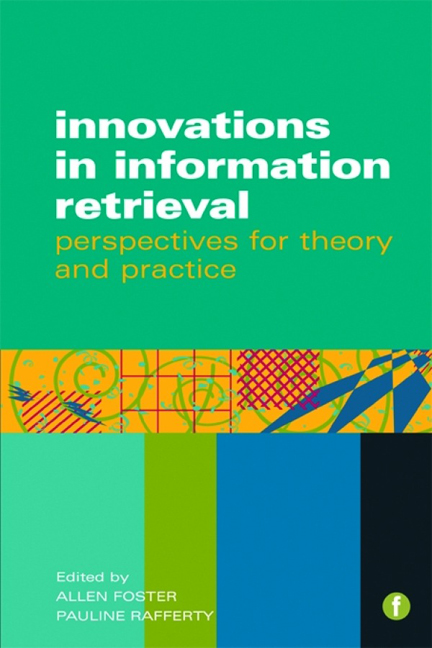Book contents
- Frontmatter
- Contents
- Figures and tables
- Contributors
- Foreword
- Introduction
- 1 Encountering on the road to Serendip? Browsing in new information environments
- 2 Classification revisited: a web of knowledge
- 3 Approaches to fiction retrieval research: from theory to practice?
- 4 Music information retrieval research
- 5 Folksonomies, social tagging and information retrieval
- 6 Digital information interaction as semantic navigation
- 7 Assessing web search engines: a webometric approach
- Index
5 - Folksonomies, social tagging and information retrieval
Published online by Cambridge University Press: 08 June 2018
- Frontmatter
- Contents
- Figures and tables
- Contributors
- Foreword
- Introduction
- 1 Encountering on the road to Serendip? Browsing in new information environments
- 2 Classification revisited: a web of knowledge
- 3 Approaches to fiction retrieval research: from theory to practice?
- 4 Music information retrieval research
- 5 Folksonomies, social tagging and information retrieval
- 6 Digital information interaction as semantic navigation
- 7 Assessing web search engines: a webometric approach
- Index
Summary
Introduction
Services in Web 2.0 generate a large quantity of information, distributed over a range of resources (e.g. photos, URLs, videos) and integrated into different platforms (e.g. social bookmarking systems, sharing platforms (Peters, 2009). To adequately use this mass of information and to extract it from the platforms, users must be equipped with suitable tools and knowledge. After all, the best information is useless if users cannot find it: ‘The model of information consumption relies on the information being found’ (Vander Wal, 2004). In Web 2.0, the retrieval component has been established through so-called folksonomies (Vander Wal, 2005a), which are considered as several combinations of an information resource, one or more freely chosen keywords (‘tags’) and a user. Web 2.0 services that use folksonomies as an indexing and retrieval tool are defined as ‘collaborative information services’ because they allow for the collaborative creation of a public database that is accessible to all users (registered, where necessary) via the tags of the folksonomy (Ding et al., 2009; Heymann, Paepcke and Garcia-Molina, 2010).
Folksonomies in information retrieval serve mainly to provide access to information resources for all users – where the initial motivation for tagging is often of a personal nature:
In my mind, at least initially, it really has do with retaining information that you, I, or anyone else has found and organizing it in a way so that people can re-find that information at some later date. Tagging bookmarks is really another way of trying to keep source […] once found on the Internet permanently found.
(Gordon-Murnane, 2006, 28)Metadata in the form of tags, titles or descriptions are especially invaluable for the retrieval of non-textual information resources such as images or videos because the state of the art of search engine technology allows only for textual research, meaning that these resources would otherwise be irretrievable (Dye, 2006). In these instances, it is also important for the retrievability of resources to be guaranteed by a broad-access vocabulary, and this is where folksonomy can provide excellent service (Goodrum and Spink, 2001, 296). Because of their strong user-orientedness and broad-access vocabulary, folksonomies can also facilitate the retrieval of relevant information in company intranets or in ‘enterprise search’ (Schillerwein, 2008).
- Type
- Chapter
- Information
- Innovations in Information RetrievalPerspectives for theory and practice, pp. 85 - 116Publisher: FacetPrint publication year: 2011
- 1
- Cited by



